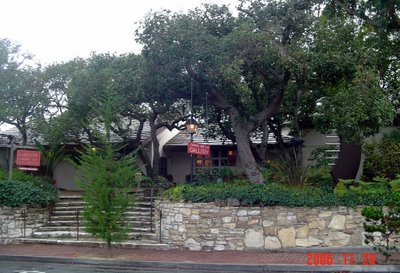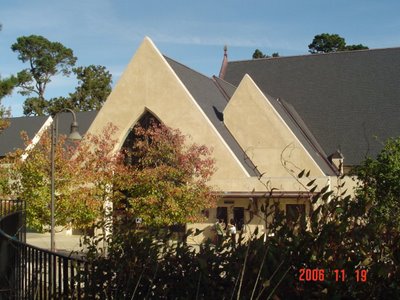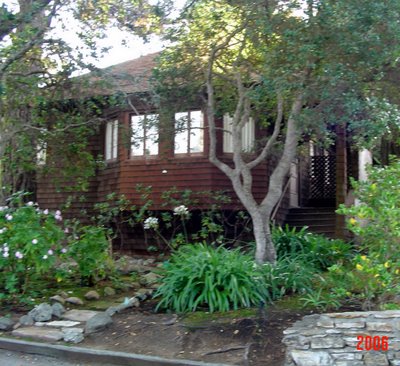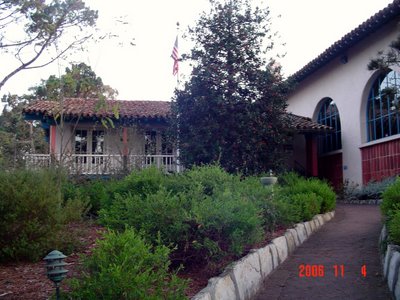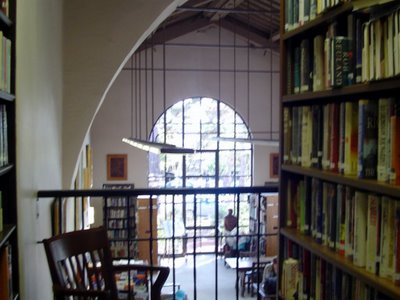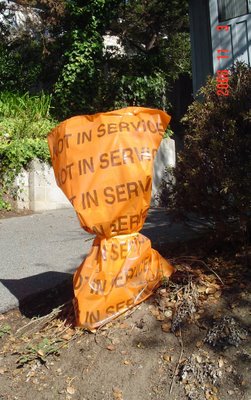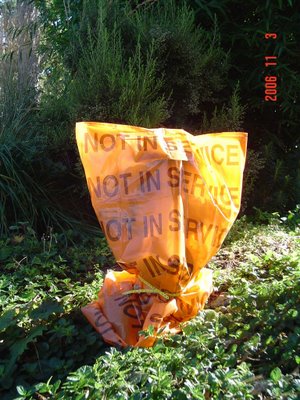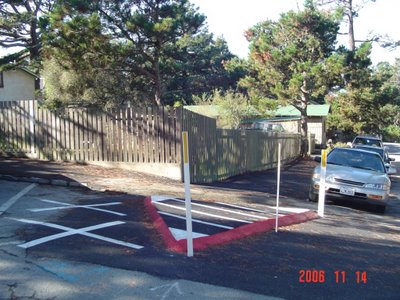
Asphalt Triangular Pavement Replaced City Tree
Location: Dolores St. & 5th Av., S.W. Corner
 QUESTIONS:
QUESTIONS: What were the circumstances surrounding the removal of a City tree at the S.W. corner of Dolores St. & 5th Avenue?
Is the asphalt triangular pavement, in lieu of the planting of a replacement tree, in concordance with the spirit and letter of the City’s Local Coastal Program? Especially in the context of the following Local Coastal Program policies:
G5-5 Maintain and enhance the informality of streetscapes. (LUP)O5-16 Remove or reduce unnecessary or excessive hardscape and other nonconforming encroachments on City parklands and within street rights-of-way to provide for and promote planting of trees and native vegetation.
(LUP)
P5-92 Look for opportunities to reduce or eliminate hardscape areas Citywide on public and private lands... (LUP)
O5-17 Use mini-parks and islands for planting trees, with an emphasis on native Monterey Pines, oaks, and other native vegetation. (LUP)
CONTEXT:Recall two previous precedents:
1. While Clayton Anderson, President of Friends of Carmel Forest, was waiting for the “City” to notify him about planting a tree in what was the Post Office Bump-Out on 5th Avenue, the “City” unilaterally, without public hearings, removed the Bump-Out to provide one extra parking space on 5th Avenue.
2. At the 5 May 2005 Forest And Beach Commission meeting, during Public Appearances, Carmelite Barbara Livingston stated that she was unable to “get answers to some questions” she had, including:
“On San Carlos east side between 13 and 12th – the tree died and the bump out was paved over. The Public Works Director and the City Forester said a tree would be planted there. How can a tree be planted when the area has been paved over? Has it become a policy of the City that once bump out/safety planters are removed they will not be replaced or is the policy still in place to replace trees in these areas?"Selected relevant excerpts from the City’s Local Coastal Program and Municipal Code regarding the City’s policies on trees, tree replacement, et cetera, as follows:General Plan/Coastal Land Use Plan
COASTAL RESOURCE MANAGEMENT ELEMENTUrbanized Forest, Parks and Open SpacesCarmel's forest is an “urbanized” Monterey pine forest rather than an “urban” forest. “Urban” forests are planted after development and typically consist of single species, regularly spaced trees planted in a row between the sidewalk and the street. An “urbanized” forest exists before development and is characterized by its diversity in species, age and randomness in tree location resulting in meandering streets of varying width. (LUP)
To many, the “urbanized” forest is the character-defining feature that makes Carmel-by the-Sea so unique. The forest, along with the beach and ocean, is the City’s largest and most visible natural resource. Homes are nestled into the native Monterey pine and Coast Live oak on a grid of streets that yields to trees more than to engineering expediency. Upper canopy trees impart a distinctive ambiance and identity to the City. Lower canopy trees soften and provide screening of development. Together the mix of upper and lower canopy trees establishes a powerful sense of place. (LUP)
The City’s Forest, Parks and Beach Department has an ongoing program of replacing dead and diseased pines on public property...LUP)
Goals, Objectives and Policies
Urban Forests, Parks and Open SpacesG5-3 Protect, conserve and enhance the unique natural beauty and irreplaceable natural resources of Carmel and its Sphere of Influence, including its biological resources, water resources, and scenic routes and corridors. (LUP)
P5-47 Continue Carmel's tree preservation program and encourage the use of indigenous or native plants. (LUP)
G5-4 Preserve and enhance the City's legacy of an urbanized forest of predominantly Monterey pine, coast live oak and Monterey Cypress. (LUP)
O5-11 Maintain, restore and enhance the upper and lower tree canopy of Carmel’s urbanized forest. (LUP)
P5-55 Implement adopted tree density policies for private and public property as appropriate to each site taking into consideration neighborhood characteristics and site constraints. (LUP)
P5-56 Establish and implement tree canopy policies for the commercial district. (LUP)
P5-57 Maintain a list of tree species that could qualify as indigenous upper and lower canopy trees, for the purposes of meeting tree density and replacement policies. (LUP)
P5-58 Maintain, restore and enhance a predominantly indigenous forest of native Monterey pines and coast live oaks. (LUP)
P5-63 Manage the tree-planting program to achieve an uneven-aged, healthy forest with particular emphasis on native Monterey pines and coast live oaks. (LUP)
G5-5 Maintain and enhance the informality of streetscapes. (LUP)
O5-16 Remove or reduce unnecessary or excessive hardscape and other
nonconforming encroachments on City parklands and within street rights-of-way to provide for and promote planting of trees and native vegetation.
(LUP)
P5-92 Look for opportunities to reduce or eliminate hardscape areas
Citywide on public and private lands...(LUP)
O5-17 Use mini-parks and islands for planting trees, with an emphasis on native Monterey Pines, oaks, and other native vegetation. (LUP)
P5-95 Recognize the City's narrow street paving, roadside vegetation and overarching canopy as important elements contributing to the streetscape, pedestrian circulation, traffic calming, community aesthetics and environmental enhancement. Identify character defining features of roadways and retain and enhance these features when planning and implementing street improvements, repairs and reconstructions. (LUP)
Carmel-by-the-Sea
Municipal Code
Chapter 17.48
TREES AND SHRUBS1
17.48.010 Purpose.The City Council finds that in order to preserve windbreaks, reduce soil erosion, and preserve the natural beauty of the City’s urbanized forest, it is necessary to maintain the extent and health of the dominant Monterey Pine forest, along with other native tree species and adopts this chapter in the interest of public health and safety. (Ord. 2004-02 § 1, 2004; Ord. 2004-01 § 1, 2004).
(Source: Carmel-by-the-Sea California – Official City Website, http://www.ci.carmel.ca.us/)
CONCLUSION:With at least three apparent violations of the intent of the City’s Local Coastal Program policies regarding Carmel-by-the-Sea’s “urbanized” forest, replacement trees, maintenance and enhancement of the city’s informal streetscape, is it the City of Carmel-by-the-Sea’s policy to unilaterally abrogate the city’s Local Coastal Program policies? Is our city at risk of losing Carmel-by-the-Sea’s “natural beauty” because of these city actions?
